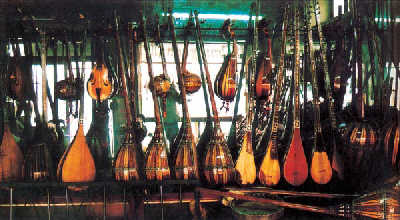|
Art of Music
( 2005-09-13 )

The Uygur music embraces several distinct regional styles, product of the geography and complex history of the region, whose oasis kingdoms, separated by mountains and deserts, have been subject through the course of history to rule by many different outside forces.
The musical traditions of the southern oasis towns of Hotan andKashgarare more closely allied to the classical Central Asian traditions of Bukhara and Samarkand, while the music of the easternmost oasis town of Qumul has closer links to the music of Northwest China. Each of the region's oasis towns have to this day maintained their own distinctive sound and repertoire, but they are linked by a common language and overarching culture, maintained by constant communication through trade and movement of peoples. Musically there is much to link these local traditions, in terms of instruments, genres, styles and contexts.
 The most prestigious and well-known genre of Uygur music is the Muqam, the large-scale suites of song, instrumental and dance music. In addition to the Muqam the Uygurs maintain popular traditions of song epic tales and other forms of narrative song; suites of dance music; instrumental music; musical genres linked to the ceremonies, and a huge repertoire of folksongs which commonly dwell on the suffering of life on earth and the torments of frustrated love. Today these traditional genres compete with a lively pop music industry and the music of the professional, state-sponsored troupes. The most prestigious and well-known genre of Uygur music is the Muqam, the large-scale suites of song, instrumental and dance music. In addition to the Muqam the Uygurs maintain popular traditions of song epic tales and other forms of narrative song; suites of dance music; instrumental music; musical genres linked to the ceremonies, and a huge repertoire of folksongs which commonly dwell on the suffering of life on earth and the torments of frustrated love. Today these traditional genres compete with a lively pop music industry and the music of the professional, state-sponsored troupes.
Known as the "mother of Uygur music," the Twelve Muqam has a long history. Some scholars believe its origin can be traced back to the "Great Western Region Melody" that flourished during the Han (206BC-AD220) and Tang (618-907) dynasties and enjoyed a high popularity in Central China.
|

